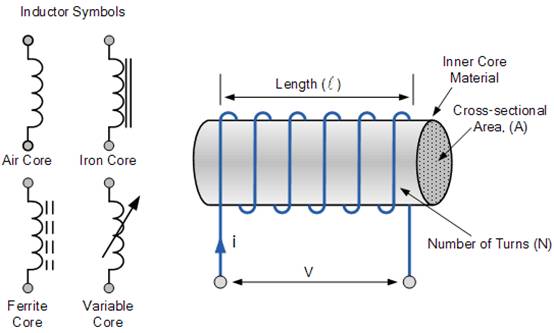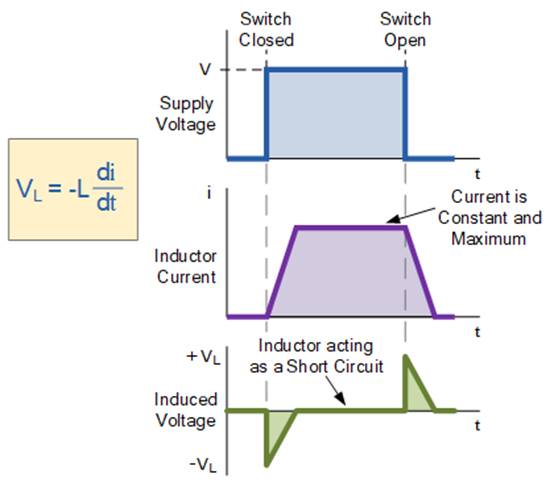An inductor is a passive electrical component consisting of a coil that is designed to exploit the relationship between magnetism and electricity as a current passes through the coil.
An inductor, also known as a choke, is also a passive electrical component consisting mainly of coils, formed by a wire tightly wound around a solid central magnetic core, which can be a straight cylindrical bar or a continuous ring or ring to concentrate its magnetic flux.
The principle symbol of the inductor is L, the unit is Henry, 1mH = 1 millillion Henry - equal to one thousandth (1/1000) of Henry.
100μH = 100 microhenrys - equal to one millionth (1/1,000,000) of Henrys.


N is the number of turns
A is the cross-sectional area in m 2
Φ is the flux in Webers
μ is the permeability of the core material
l is the length of the coil in meters
di/dt is the rate of change of current in amperes per second

Current and voltage in an inductor
Current in inductor
The amount of induced voltage produced by the inductor depends on the rate of current change. In our tutorial on electromagnetic induction, Lenz's Law states that "the direction of the induced electromotive force is always opposite to the change that causes it". In other words, the induced electromotive force will always oppose the motion or change that initiates the induced electromotive force in the first place.
Thus, as the current decreases, the voltage polarity will act as a power source, while as the current increases, the voltage polarity will act as a load. Therefore, for the same rate of change of current through the coil, the amplitude of increase or decrease of induced electromotive force will be the same.
A 4 amp steady state DC current flows through a 0.5H solenoid coil. If the switch in the above circuit is on for 10 milliseconds and the current flowing through the coil drops to zero amps, what is the average back electromotive force voltage induced in the coil?

The induced voltage in the inductor
The power in the inductor
We know that the inductor in the circuit prevents the current (i) from flowing through it, because the current induces an electromotive force that is opposite to it, namely Lenz's law. The work must then be done by an external battery power source to keep the current flowing through this induced electromotive force. The instantaneous power used to force the current (i) against the self-induced electromotive force (VL) is given by the above formula:

Generate a back electromotive force
The power in the circuit is P = V*I so:

The ideal inductor has no resistance, only inductance, so R = 0 Ω, so there is no power dissipation within the coil, so we can say that the power loss of the ideal inductor is zero.
免责声明: 本文章转自其它平台,并不代表本站观点及立场。若有侵权或异议,请联系我们删除。谢谢! Disclaimer: This article is reproduced from other platforms and does not represent the views or positions of this website. If there is any infringement or objection, please contact us to delete it. thank you! |


